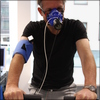Wonderful World of Blood with Michael Moseley
Wonderful World of Blood with Michael Moseley
Xtreme Everest’s Dr Dan Martin and Dr Edward (Ned) Gilbert-Kawai featured on the recent BBC Four documentary “The Wonderful World of Blood with Dr Michael Mosley”.
Dr Michael Mosely, who is famed for his previous documentaries where he has looked at the fascinating world of parasites and explored “The truth about exercise”, came to the Institute of Sport Exercise and Health (ISEH) where both the Xtreme Everest and CASE Medicine are based, to look at how blood is affected at altitude.
Taking advantage of the skills and knowledge of the Xtreme Everest team, Dr Mosely was put through a series of tests at the ISEH, which the team have also undertaken at Everest base camp in both 2007 and 2013. Included was a CPET test to look at his VO2 max, which will show the maximum rate his blood can pass oxygen to his muscles.
Dr Gilbert-Kawai took the chance to also show Michael his capillaries, which are the smallest blood vessels in the human body, using an IDF (Incident Darkfield Imaging) camera. Xtreme Everest undertook this testing at both sea level and altitude on their expeditions to look at difference in flow at the different heights but also to see if there was significant difference between lowlanders and Sherpas.
The programme also explained how Xtreme Everest has undertaken research at altitude in the Himalayas, to look at what low oxygen environments can do to the human body and if we can learn anything from this that can be taken back to patients to improve survival rates.
Dr Martin invited Dr Mosley to visit the hypoxic chamber for four hours, taking him to a “height” of 4,500 meters which is around 12% oxygen. The ISEH’s hypoxic chamber allows researchers to recreate these environments at sea level. As Dr Mosley says “I just have to cross the room” within the ISEH Laboratory and he can be at the summit of Mont Blanc.
The chamber at the ISEH allows researchers to reduce oxygen levels to examine in-depth how the body takes on and uses oxygen, providing valuable insights into how intensive care patients who have hypoxia (lower oxygen levels), can be helped in the future. Dr Martin explains how Michael’s body will sense the reduced level of oxygen prompting his heart to pump faster and harder to push more oxygen around his body to compensate for the lack of oxygen. Dr Mosley finds after an hour his oxygen levels have dropped to 80% and he begins to feel very unwell. This is typical of what patients in intensive care will also experience as their oxygen levels drop. After four hours in the chamber there is a 40% difference in his erythropoietin jumping from 5.5mU/ml to 7.7mU/ml.
As Michael notes, to explore what happens to our blood in low oxygen environments further he would need to live in the chamber for a month. Xtreme Everest investigators and team spent three months living at altitude during their two expeditions, helping to show significant changes in the human body which could be used to improve patient care in the future.
To watch the documentary in full, visit the BBC iPlayer

 The Wonderful World of Blood
The Wonderful World of Blood


